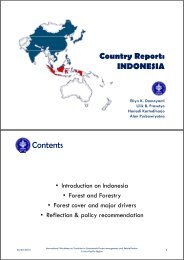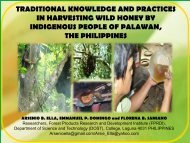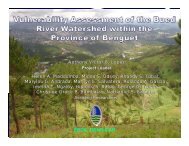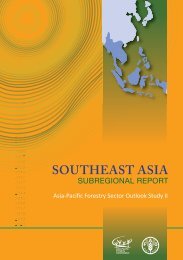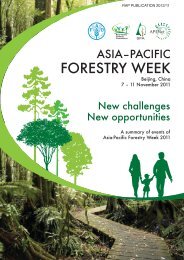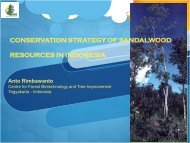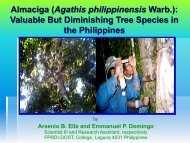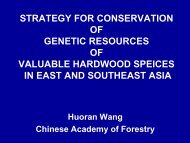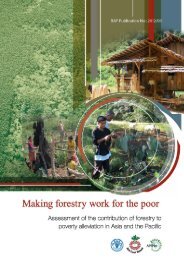Genetic Diversity of Aquilaria crassna - APAFRI-Asia Pacific ...
Genetic Diversity of Aquilaria crassna - APAFRI-Asia Pacific ...
Genetic Diversity of Aquilaria crassna - APAFRI-Asia Pacific ...
- No tags were found...
Create successful ePaper yourself
Turn your PDF publications into a flip-book with our unique Google optimized e-Paper software.
<strong>Genetic</strong> <strong>Diversity</strong> <strong>of</strong> <strong>Aquilaria</strong> <strong>crassna</strong>(Thymelaeaceae) in Thailand usingMicrosatellite Markers1,2Sudarat Buapech, 1 Suchitra Changtragoon, 2 Wichan Eiadthong1 Forest <strong>Genetic</strong> and Biotechnology Research Division, Forest and Plant ConservationResearch <strong>of</strong>fice, National Park, Wildlife and Plant Conservation Department, Thailand2 Department <strong>of</strong> Forest Biology, Faculty <strong>of</strong> Forestry Kasetsart University, Thailand
<strong>Aquilaria</strong> <strong>crassna</strong> or Agarwood• Family Thymelaeaceae•genus <strong>Aquilaria</strong>Distributed from India, Burma,Indochina, SE China andwidespread in SE <strong>Asia</strong>
Thailand<strong>Aquilaria</strong> <strong>crassna</strong> Pierre ex H. Lec.A. malaccensis Lamk.A. rugosa L.C. Kiet & KresslerA. hirta Ridl.A. subintegra Ding Hou.
USEtraditional medicineIncensePerfumeCosmeticsTea
Increasing demand andhigh price• seven <strong>Aquilaria</strong> species arecategorized as vulnerable• A. <strong>crassna</strong> recognized in IUCNred list as critically endangered
Houpooling,Mae Hong Son, ThailandAll species <strong>of</strong> <strong>Aquilaria</strong>and Gyrinops wereplaced on the AppendixII list <strong>of</strong> Convention onInternational Trade inEndangered Species <strong>of</strong>Wild Fauna and Flora(CITES) to improvecontrol <strong>of</strong> commercialagarwood tradePhu luang Wildlife Sanctuary,Loei, Thailand
Molecular markers• Biochemical markersIsozymeProduct <strong>of</strong> gene• DNA-based markersRAPDAFLPMicrosatellite (SSR)DNA
Microsatellite marker• SSR markerCore sequence 1-6 base• PCR based• Codominant• Highly quantity<strong>of</strong> information• High cost <strong>of</strong> development
ObjectivesThis study were to measure genetic variationand population genetic structure in naturalpopulations <strong>of</strong> A. <strong>crassna</strong> in Thailand and tosuggest guidelines for species conservation usingthe acquired genetic information
Materials and methods
Collection <strong>of</strong> the sample41 Khon Kaen (KKN)3122 Udon Thani(UDN)3 Phetchabun (PNB)5674 Chiang Mai (CMI)5 Prachinburi(PRI)6 Chanthaburi (CTI)7 Trat (TRT)20 samples per population
Extract DNALiquidnitrogenCTABCentrifugationIsopropanolPrecipitationCentrifugationThree timesCIAThree timesEthanolCentrifugationRNase
Genomic DNA <strong>of</strong> agarwoodM 1 2 3 4 5 6 7 8 9 10 11 MElectron(-)(M = 1 Kb ladder marker)(+)
Polymerase Chain Reaction• DNA (25 ng/l) 2 l• Primer F (10 M)0.5 l• Primer R (10 M)0.5 l• 10X PCR Buffer (15 mM MgCl 2 ) 1 l• dNTP (1 mM) 1 l• Taq DNA polymerase 0.1 l• Ultra pure water4.9 l• Total10 l
Polymerase Chain Reaction1.Pre-heat 94 ๐ C 3 min2. Denature 94 ๐ C 30 sAnnealing 50-64 ๐ C 30 sExtension 72 ๐ C 1 s28 cycles3. Final extension 72 ๐ C 5 min
Microsatellite loci and conditions <strong>of</strong> annealing temperatures(Tm), repeat pattern, allele size, for six polymorphicmicrosatellite loci in <strong>Aquilaria</strong> <strong>crassna</strong>Locus Repeat motif Primer sequence(5'-3') Tm( o C)Expectedallelesize(bp)6pa18 (CA) 8 F: TGAGGCGTGAGTGAGATATTGATT 50 210R: CCTTCCTCTCTTCTTACCTCACCA10pa17 (CA) 12 F: CACACACTCTTATGGTCTACAGCTTR:TTCGCCATCTCATAATATTCTAATGTA16pa17 (CA) 19 F: AGTGAACAACTTGACTACGCTTGR:GCTGAACACAACAACATATCACCBMX1 (AG) 22 F: GTGAAGTGAGGAGACGCAGCCR:CAGAAACCCTACCCGAACAGBMX3 (AG) 20 F:CCAAGCCTCACAAGGATTGTCR:CCCTAAATGCGACGGTBMX7 (AG) 15 F:TCTTTTGTGAGGTAGGCCATT50 15656 15562 39764 36562 366R:CCTCTTCTCTTCCGCTTCCF, forward; R, reverse.
Polymerase chain reaction(PCR)ElectrophoresisNon-denaturing polyacrylamide gel- 6% polyacrylamide- EtBr- Real time laser scanning electrphoresis(Gelscan 3000)
Prachinburi population , primer 10pa17
DATA ANALYSIS• average number <strong>of</strong> alleles per locus ,A• the average effective number <strong>of</strong> alleleper locus, Ne• heterozygosityobserved heterozygosity, H oexpected heterozygosity, H eTFPGA v.1.3• genetic distance• an unweighted pair group method witharithmetic average (UPGMA)
Results and Discussion
Number <strong>of</strong> individuals in population (N), alleles per locus(Na), effective number <strong>of</strong> alleles (Ne), observed (Ho) andexpected heterozygosity (He) in <strong>Aquilaria</strong> <strong>crassna</strong>populations over all lociPopulation N Na Ne Ho HeKhon Kaen 20 2.83 2.03 0.4167 0.5060Udon Thani 20 2.83 2.54 0.5074 0.5028Phetchabun 20 3.17 2.06 0.5000 0.4573Chiang Mai 20 2.33 1.62 0.5083 0.3626Prachinburi 20 2.83 1.89 0.5333 0.4417Chanthaburi 20 2.50 2.03 0.5000 0.4607Trat 20 2.33 2.05 0.5000 0.4553Overall 20 2.69 2.03 0.4951 0.4552
<strong>Genetic</strong> distance between populations.POP KKN UDN PNB CMI PRI CTI TRTKKN *****UDN 0.1571 *****PNB 0.4342 0.4245 *****CMI 0.4361 0.4052 0.4588 *****PRI 0.2456 0.2686 0.4752 0.4343 *****CTI 0.2575 0.2767 0.4123 0.5658 0.2310 *****TRT 0.2897 0.2746 0.4599 0.5576 0.2867 0.1598 *****
Dendrogram
CBAAAA A
Conclusion and suggestion• average number <strong>of</strong> alleles per locus, A = 5.83• the average effective number <strong>of</strong> alleles per locus, Ne = 2.69• expected heterozygosity (H e )highest in Khon Kaen population = 0.5060lowest in Chiang Mai population = 0.3626• UPGMA tree separated the populations into three groups(A, B, and C)A = population from the Northeast and the EastB = population from the WestC = population from the North
Conclusion and suggestion• The genetic diversity and distance reflectedgeographic distribution• Future, should find private and unique alleles specific tothe Sub-region <strong>of</strong> Thailand, since the results shows thereflection <strong>of</strong> genetic variation and population distribution•Unique and private alleles for each pop and sub regionscan be use for illegal wood forensics in the future
Provides data on the genetic diversity <strong>of</strong> A. <strong>crassna</strong>ImprovementIn situEx situSustainable yield
THANK YOU• Department <strong>of</strong> National Park, Wildlifeand Plant Conservation, Bangkok ,Thailand• Graduate School, Kasetsart University,Bangkok , Thailand
THANK YOU FOR ATTENTION




